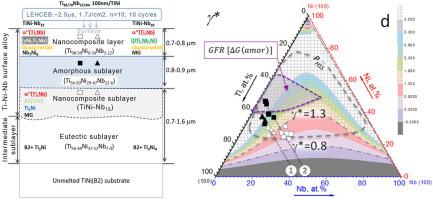当前位置:
X-MOL 学术
›
Mater. Charact.
›
论文详情
Our official English website, www.x-mol.net, welcomes your feedback! (Note: you will need to create a separate account there.)
Microstructural characterization and mechanical behavior of nanocomposite Ti-Ni-Nb surface alloys synthesized on TiNi SMA substrate by additive thin-film electron-beam mixing
Materials Characterization ( IF 4.7 ) Pub Date : 2020-08-01 , DOI: 10.1016/j.matchar.2020.110455 L.L. Meisner , V.P. Rotshtein , V.O. Semin , A.B. Markov , E.V. Yakovlev , S.N. Meisner , D.A. Shepel , A.A. Neiman , E.Yu. Gudimova , F.A. D'yachenko , R.R. Mukhamedova
Materials Characterization ( IF 4.7 ) Pub Date : 2020-08-01 , DOI: 10.1016/j.matchar.2020.110455 L.L. Meisner , V.P. Rotshtein , V.O. Semin , A.B. Markov , E.V. Yakovlev , S.N. Meisner , D.A. Shepel , A.A. Neiman , E.Yu. Gudimova , F.A. D'yachenko , R.R. Mukhamedova

|
Abstract An important factor limiting the wide application of magnetron-sputtered amorphous or nanocomposite thin-film coatings for improving surface-sensitive properties of structural alloys is the poor adhesion of coating to substrate. This problem can be overcome through the synthesis of surface alloys (SAs) by additive pulsed electron-beam melting of film/substrate systems of high glass-forming ability (GFA). In this work, this approach is applied to the “film (Ti85/70Nb15/30, at.%), 100 nm/substrate (TiNi SMA)” system using low-energy, high-current electron beam (~2.5 μs, ~15 keV, 1.7 J/cm2) at 10 synthesis cycles and 10 pulses per cycle. The melting/solidification conditions were evaluated using numerical modeling of pulsed heating, taking into account the formation of eutectic in the Ti-Ni-Nb system and initial temperature risen up to 473 K to the end of the synthesis. Using surface SEM/EDS, AES, XRD and cross-sectional HRTEM/EDS/SAED analyses it has been found that both SAs of thickness ~1.5–2 μm have depth-graded structure, in which outer Ni-depleted layer is the multiphase nanocomposite with quasicrystals followed by predominantly Ti-Ni-based amorphous sublayer. Beneath, the ~1 μm thick intermediate sublayer with eutectic columnar structures (B2 + Ti2Ni and B2 + Ti3Ni4 for first and second SA, correspondently), monotonic Nb substitution for Ni and diffusion transition to TiNi substrate is formed. Depth-graded structure of modified surface layers provides monotonic changes with depth in nanohardness, elastic modulus, depth recovery ratio and plasticity to the values of the TiNi substrate. For both SAs the evolution of structure in depth is in a reasonable agreement with glass forming composition range evaluated for Ti-Ni-Nb system using Miedema's model.
中文翻译:

通过添加薄膜电子束混合在 TiNi SMA 基底上合成的纳米复合 Ti-Ni-Nb 表面合金的显微结构表征和力学行为
摘要 限制磁控溅射非晶或纳米复合薄膜涂层在改善结构合金表面敏感性方面的广泛应用的一个重要因素是涂层与基材的附着力差。这个问题可以通过添加脉冲电子束熔化高玻璃形成能力 (GFA) 的薄膜/基材系统合成表面合金 (SA) 来克服。在这项工作中,这种方法被应用于“薄膜(Ti85/70Nb15/30,at.%),100 nm/衬底(TiNi SMA)”系统,使用低能量、高电流电子束(~2.5 μs,~ 15 keV, 1.7 J/cm2) 在 10 个合成周期和每个周期 10 个脉冲。使用脉冲加热的数值模型评估熔化/凝固条件,考虑到在 Ti-Ni-Nb 体系中形成共晶,初始温度上升到 473 K 到合成结束。使用表面 SEM/EDS、AES、XRD 和横截面 HRTEM/EDS/SAED 分析发现,厚度约为 1.5-2 μm 的 SA 都具有深度渐变结构,其中外部镍耗尽层是多相纳米复合材料准晶体,然后是主要的 Ti-Ni 基非晶亚层。在下面,约 1 μm 厚的中间亚层具有共晶柱状结构(B2 + Ti2Ni 和 B2 + Ti3Ni4 对应地用于第一和第二 SA),单调 Nb 取代 Ni 和扩散过渡到 TiNi 衬底形成。改性表面层的深度分级结构在纳米硬度、弹性模量、深度恢复比和塑性对 TiNi 基体的值。对于这两种 SA,深度结构的演变与使用 Miedema 模型为 Ti-Ni-Nb 系统评估的玻璃形成成分范围合理一致。
更新日期:2020-08-01
中文翻译:

通过添加薄膜电子束混合在 TiNi SMA 基底上合成的纳米复合 Ti-Ni-Nb 表面合金的显微结构表征和力学行为
摘要 限制磁控溅射非晶或纳米复合薄膜涂层在改善结构合金表面敏感性方面的广泛应用的一个重要因素是涂层与基材的附着力差。这个问题可以通过添加脉冲电子束熔化高玻璃形成能力 (GFA) 的薄膜/基材系统合成表面合金 (SA) 来克服。在这项工作中,这种方法被应用于“薄膜(Ti85/70Nb15/30,at.%),100 nm/衬底(TiNi SMA)”系统,使用低能量、高电流电子束(~2.5 μs,~ 15 keV, 1.7 J/cm2) 在 10 个合成周期和每个周期 10 个脉冲。使用脉冲加热的数值模型评估熔化/凝固条件,考虑到在 Ti-Ni-Nb 体系中形成共晶,初始温度上升到 473 K 到合成结束。使用表面 SEM/EDS、AES、XRD 和横截面 HRTEM/EDS/SAED 分析发现,厚度约为 1.5-2 μm 的 SA 都具有深度渐变结构,其中外部镍耗尽层是多相纳米复合材料准晶体,然后是主要的 Ti-Ni 基非晶亚层。在下面,约 1 μm 厚的中间亚层具有共晶柱状结构(B2 + Ti2Ni 和 B2 + Ti3Ni4 对应地用于第一和第二 SA),单调 Nb 取代 Ni 和扩散过渡到 TiNi 衬底形成。改性表面层的深度分级结构在纳米硬度、弹性模量、深度恢复比和塑性对 TiNi 基体的值。对于这两种 SA,深度结构的演变与使用 Miedema 模型为 Ti-Ni-Nb 系统评估的玻璃形成成分范围合理一致。



























 京公网安备 11010802027423号
京公网安备 11010802027423号